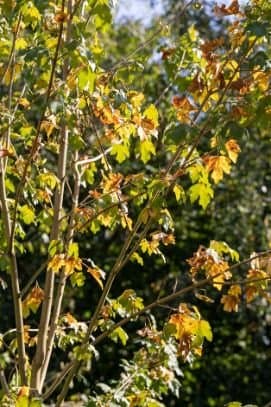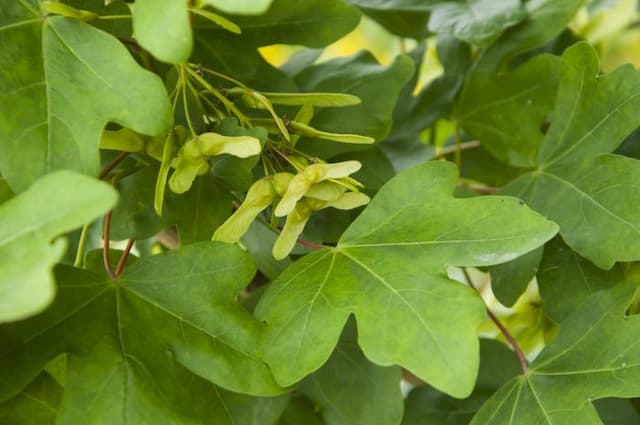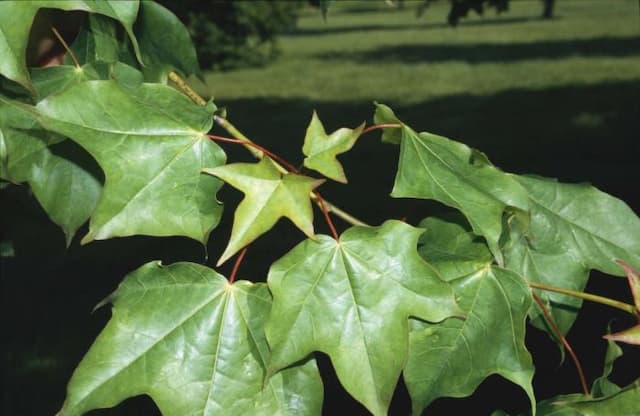Forrest's Maple Acer forrestii

ABOUT
Acer forrestii, commonly known as the Forrest's maple, is a deciduous tree known for its attractive foliage and ornamental value in landscapes. While avoiding specifics about its size, the visual characteristics of this plant are quite distinctive. The Forrest's maple has a rounded canopy with a layer of lush leaves. The leaves typically have a classic maple shape, which includes three or five pointed lobes. They offer a seasonal display, changing colors with the onset of autumn. Initially, the leaves are a vibrant green, but as the cooler months approach, they transition to vivid shades of red and orange, providing a striking contrast to the landscape. This tree is also well-recognized for its bark. Young trees have smooth, gray bark that gradually becomes more furrowed and textured with age, adding to the character of the tree. Additionally, the Forrest's maple produces small, inconspicuous flowers. The blossoms may be followed by the formation of winged seeds, known as samaras, which helicopter down from the branches when ripe. As a part of its ornamental appeal, the Forrest's maple is sometimes noted for its attractive branching pattern, providing visual interest even in the absence of leaves during the winter months. The branches often grow in a pleasing, somewhat layered structure and can provide habitat for various species of wildlife. Overall, Acer forrestii is admired for its seasonal beauty and contribution to the aesthetic of gardens and natural settings where it is grown.
About this plant
 Names
NamesFamily
Sapindaceae
Synonyms
Forrest's Maple
Common names
Acer forrestii subsp. forrestii, Acer forrestii var. forrestii.
 Toxicity
ToxicityTo humans
The plant known as Forrest's Maple (Acer forrestii) is not commonly listed as a toxic plant to humans. There is no widespread information available on the toxicity of this particular maple species to humans. However, as a general rule, unless a plant is known to be edible, it's advised to avoid ingestion of any plant parts to prevent any potential but unreported toxic effects.
To pets
Forrest's Maple (Acer forrestii) is not commonly listed as a toxic plant to pets such as dogs and cats. There is a lack of specific information regarding the toxicity of this particular species of maple to pets. Generally, some maples are known to be toxic to horses, causing a condition called equine atypical myopathy, but this is not typically associated with dogs and cats. As with humans, it is generally wise to prevent pets from ingesting plants not known to be safe.
 Characteristics
CharacteristicsLife cycle
Perennials
Foliage type
Deciduous
Color of leaves
Green
Flower color
Varies
Height
20 feet (6 meters)
Spread
15 feet (4.5 meters)
Plant type
Tree
Hardiness zones
7
Native area
China
Benefits
 General Benefits
General Benefits- Ornamental Value: Acer forrestii, commonly known as Forrest's Maple, is appreciated for its striking fall foliage colors, providing aesthetic value to gardens and landscapes.
- Shade Provider: The tree offers shade in yards and parks, making outdoor spaces more comfortable during sunny days.
- Habitat Support: Its structure and leaves provide shelter and food for various species of wildlife including birds and insects.
- Erosion Control: The root system of Forrest's Maple helps to stabilize the soil, reducing erosion especially on slopes and banks.
- Climate Tolerance: It can withstand a range of climatic conditions, making it a versatile choice for different landscape settings.
- Seasonal Interest: The tree's seasonal changes from green summer leaves to vibrant autumn colors offer year-round interest in the landscape.
- Low Maintenance: Acer forrestii is known for being a low maintenance tree, requiring minimal care once established.
 Medical Properties
Medical PropertiesThis plant is not used for medical purposes.
 Air-purifying Qualities
Air-purifying QualitiesThis plant is not specifically known for air purifying qualities.
 Other Uses
Other Uses- Acer forrestii, commonly known as Forrest's Maple, can be used as a natural dye; its leaves and bark may produce colors for textile dyeing.
- The wood of Forrest's Maple is sometimes used in woodworking for items like small wooden crafts, due to its fine grain and workability.
- Forrest's Maple can serve as a food source for wildlife; birds and small mammals often eat the winged seeds.
- Its striking foliage can be used for decorative purposes in floral arrangements, especially in autumn when leaves turn bright colors.
- The tree's sap could potentially be used as a base for syrups and sweeteners, though not as commonly as with some other maples like Acer saccharum.
- Forrest's Maple can be utilized in bonsai practices, given its interesting bark texture and form.
- The leaves and branches can serve as a natural mulch, providing nutrients to the soil as they decompose.
- When planted in urban environments, Forrest's Maple can act as a privacy screen due to its dense foliage.
- This maple species can be used in artistic photography practices, as its vibrant autumn colors provide a compelling subject in landscape photography.
- Lastly, Forrest's Maple can aid in noise reduction when planted in a row to create a sound barrier due to its dense foliage and thick branches.
Interesting Facts
 Feng Shui
Feng ShuiThe Chinese Red Birch is not used in Feng Shui practice.
 Zodiac Sign Compitability
Zodiac Sign CompitabilityThe Chinese Red Birch is not used in astrology practice.
 Plant Symbolism
Plant Symbolism- Strength and Endurance: As a member of the maple family, Acer forrestii often symbolizes strength and the ability to withstand challenges due to the hardwood nature of many maples.
- Resilience: The ability of this plant to thrive in various conditions reflects resilience and adaptability in the face of change.
- Growth and Renewal: Many maples, including Acer forrestii, experience a vibrant change of color in their leaves, often symbolizing growth and the cycle of renewal in life.
- Wisdom: In some cultures, maples are considered a symbol of wisdom and longevity, reflecting the tree's often long lifespan and the value of accumulated knowledge over time.
 Water
WaterFor the Chinese Red Birch, it's important to maintain consistent soil moisture, especially during dry spells. Water the tree deeply every week with about 1.5 to 2 gallons per inch of trunk diameter at breast height. During hotter months or in particularly dry climates, increase the frequency to twice a week. Avoid shallow watering, as it does not encourage deep root growth. Always check the soil moisture before watering; if the top couple inches of soil are dry, it's time to water. Ensure that the soil has good drainage to prevent root rot.
 Light
LightChinese Red Birch thrives best in full sun to partial shade. The ideal spot would provide at least four to six hours of direct sunlight each day. However, in areas with extremely hot summers, light afternoon shade can help prevent leaf scorch. A location that offers morning sunlight with some protection from harsh afternoon rays is ideal for this tree.
 Temperature
TemperatureThe Chinese Red Birch is hardy and can withstand a range of temperatures. It can survive in temperatures as low as -20°F and as high as 80°F. The ideal temperature range for optimal growth is between 60°F and 75°F. It's important to protect the tree from extreme temperature fluctuations, especially during the growing season.
 Pruning
PruningPruning the Chinese Red Birch should be done to remove any dead or broken branches, to shape the tree for aesthetic purposes, and to maintain its health by enhancing air circulation. The best time to prune is late winter or early spring before new growth begins. Remove no more than 25% of the crown at a time to avoid stressing the tree. Always make clean cuts at a 45-degree angle just above a node or side branch.
 Cleaning
CleaningAs needed
 Soil
SoilForrest Maple prefers well-draining, fertile soil with a slightly acidic to neutral pH, typically around 5.5 to 7.5. A mix containing loam, peat, and coarse sand or perlite is ideal to facilitate good drainage and provide adequate nutrients.
 Repotting
RepottingForrest Maple trees, being relatively slow growers, do not require frequent repotting. Young trees should be repotted every 2 to 3 years to ensure they have sufficient room to grow. Older, more established trees may only need repotting every 4 to 5 years.
 Humidity & Misting
Humidity & MistingForrest Maple thrives in moderate to high humidity levels, often preferring a humidity level of around 60% if possible. However, the tree is quite adaptable and can tolerate the average outdoor humidity in most temperate climates.
 Suitable locations
Suitable locationsIndoor
Place in bright, indirect light and ensure moderate humidity.
Outdoor
Plant in partial shade, shelter from strong winds, and mulch the root zone.
Hardiness zone
6-9 USDA
 Life cycle
Life cycleAcer forrestii, commonly known as Forrest's Maple, begins its life cycle as a seed, typically dispersed by the wind due to its winged samara structure. Once the seed lands in a suitable location, it undergoes germination and develops a radicle that will form the root system. As the seedling emerges, it grows into a young sapling with juvenile leaves that photosynthesize to provide energy for further growth. Through the years, Forrest's Maple undergoes a vegetative stage, marked by yearly growth increments of branches and leaves and the development of a robust trunk. In maturity, the tree reaches reproductive age, producing flowers which, upon successful pollination, develop into the characteristic winged samaras. Finally, the mature tree may live for decades or even centuries, contributing to the forest canopy and ecosystem until senescence leads to its decline and eventual death, completing the life cycle.
 Propogation
PropogationPropogation time
Spring to Summer
Acer forrestii, commonly known as Forrest's Maple, can be propagated using several methods, but the most popular one involves seed stratification followed by sowing. Seed propagation should typically begin in the fall. The seeds require a period of cold stratification to break dormancy, which can be achieved by mixing them with moist sand and storing them in the refrigerator for approximately 90 to 120 days at 33-41 degrees Fahrenheit (0.5-5 degrees Celsius). Once stratified, the seeds can be sown in well-draining soil in a cold frame or undercover, as frost can improve germination rates. Seedlings need to be protected from extreme conditions until they are strong enough to be planted out in their final position.






![Freeman maple [Autumn Blaze]](/_next/image?url=https%3A%2F%2Fplants-admin.emdemapps.com%2Fimages%2Fplants%2F%2Fimages%2F604b575b84d87.png&w=640&q=75)


